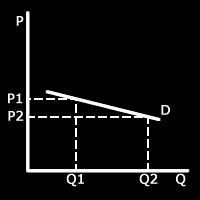Individual and market demand
Individual demand is the demand one individual or firm might have for a product at each price in a given time period. As it is just the choice of one person it can be quite volatile.
Market demand is the total demand for a product from all potential customers in the market. This gives a more balanced view of the products potential.
If we were talking about demand for meals from the student cafeteria, then individual demand would be the demand that one student has for meals from the cafe. The total demand would be the demand from all students who might buy food from the cafeteria.
Exam style questions
Use the space below each question or a pen and paper to write your answer. When complete click the button for the answer and mark scheme.
NOTE: Answers typed into the browser will not be retained if you leave the page or refresh
Questions
Explain what is meant by demand. (2 marks)
The willingness and ability(1) to buy a good or service at each price in a certain time period.(1)
Explain what the law of demand is. (2 marks)
The demand for a good or service is inversely related to the price(1) i.e. as the price rises demand falls and vice versa.(1)
Explain how the difference between individual demand and market demand. (2 marks)
Individual demand is the amount of a good or service that an individual would buy at each price in a given time period(1)
Market demand is the total demand from all potential customers at each price in a given time period.(1)
Draw an elastic demand curve. (2 marks)

You don't have to draw the dotted lines but you need to make sure you labelled the x and y axis and the demand curve itself.
You should
have drawn something that is very flat and nowhere near 45 degrees.
1 mark for the line at the right angle, 1 mark for all the labels.
Explain what price elasticity of demand is. (2 marks)
The responsiveness of demand(1) to a change in price.(1)
Case study/Scenario
Wimmers Soft Drinks is a small regional soft drink manufacturer. Their drinks tend to be slightly more expensive than the big players in the soft drink industry but they are made without preservatives and artificial sweeteners.
Analyse the factors that could lead to a right shift of demand for Wimmers Soft Drinks. (6 marks)
Sample answer:
If average incomes rise then people can afford more luxury goods like soft drinks {AO1} Because Wimmers makes premium drinks this could benefit them as more people can afford to try their product.{AO2} This may lead to
people enjoying it and becoming regular customers and demand increasing{AO3a} which if sustained will mean higher profits in the future.{AO3a}
If tastes change such that artificial sweeteners become less popular then people
will be more likely to buy Wimmers soft drinks. {AO2} This coukd lead to an increasin reveneue and more profit for Wimmers.{AO3a}
Additional notes:
Make sure you are in context. Here I have talked about soft drinks and mentioned
the point made in the scenario about them being a premium brand.
It's an analyse question so you are looking to provide a piece of knowledge. Then you need to apply it twice and analyse what that means.
There is no need for
a concluding statement.
Other arguments you could have put forward include a successful marketing campaign, an increase in the size of the population, an increase in the price of substitutes or the scrapping of the sugar tax.
Case study/Scenario
Franz is a retired carpenter with 5 grandchildren. He was disappointed with the quality of the toys his grandchildren had with most items made of plastic and easily breakable. Franz decided to use his spare time to create
wooden toy trucks and cars like the ones he grew up with that are harder to break. He sells these from November until Christmas at his local market in the town square every Sunday. He uses the money from selling the toys to treat
his grandchildren.
Recently he has been talking to Renata who runs the stall next door selling hand-made paper products. She has said she thinks demand for his toys is price elastic as she found her paper products were.
Evaluate the importance of price elasticity of demand to Franz. (6 marks)
Sample answer:
If Renata is correct and his toys have price elastic demand{AO2}then if he lowers the price of his toys by 5% then he will sell more than 5% more toys and make more revenue{AO3a} and this will likely lead to increased
profits giving him more money to spend on his grandchildren.{AO3a}
However, it may be that maximising profit is not Franz' main goal. After all, originally providing a quality product was very important to him. {AO3b}
It may also be that making more toys would turn it from a hobby into a job and take up too much of his time. {AO3b}
If Franz wants to maximise his profits so he has more to spend on his grandchildren then knowing his PED
will be important in making the right rice decisions to maximise his revenue. But if Franz feels he gets out of it what he needs to and would not be comfortable giving up more time to complete the work or might worry the quality might
drop then it will not be important to him.{AO3b}
Additional notes:
By mentioning talking about toys instead of goods and referncing information from the scenario such as his interest in quality we ensure the answer
is in context.
Because it's an evaluate you should be looking for both sides of the argument.
When it comes to the final statement you are not saying whether you think it will be important or not but giving the circumstances
where each might be the case for Franz.
<< Previous: Role of markets Next: Supply >>